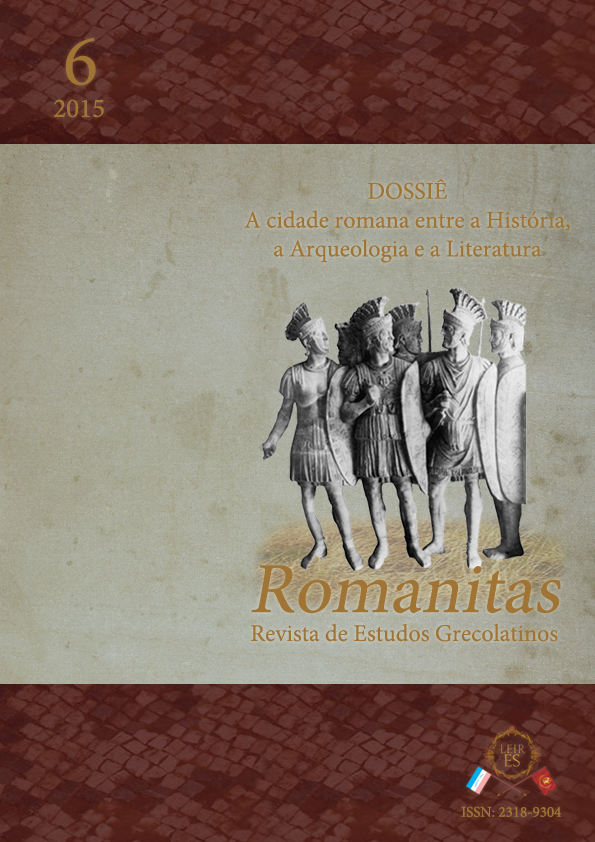Os espaços da justiça em Antioquia: o dicastério e o bouleutério
DOI:
https://doi.org/10.17648/rom.v0i6.11974Palavras-chave:
Antiguidade Tardia, Império Romano tardio, Síria antiga, Antioquia de OrontesResumo
Antioquia de Orontes foi uma cidade importante durante a Antiguidade Tardia. O espaço urbano antioqueno e foi alvo de várias disputas simbólicas e materiais, de ressignificações e reutilizações. A representação do espaço urbano nas obras de Libânio é algo que, recentemente, tem fomentado bastante contribuições ao nosso conhecimento sobre a cidade de Antioquia. Não obstante, ainda nos parece lacunar uma compreensão acerca do espaço urbano antioqueno relacionado às práticas jurídicas. No presente artigo, nos propomos a refletir sobre os espaços de exercício de práticas jurídicas antigas segundo Libânio de Antioquia dada a importância, em particular, dos aprisionamentos em massa, como podemos observar no caso específico do Levante das Estátuas, ocorrido em 387 d.C.
Downloads
Referências
Documentação textual
JOHN CHRYSOSTOM. The Homilies on the Statues to People of Antioch. In: SCHARFF, P. (Ed.). Nicene and Post-Nicene Fathers of the Christian Church. Michigan: T&T Clark, 1996. p. 315-514. v. IX.
LIBANIUS. The Riots of the Statues. In: NORMAN, A. F. (Ed.). Libanius: selected works. Harvard: Harvard University Press, 1978, p. 235407.
______. ‘Antiochikos’: in praise of Antioch. In: NORMAN, F. A. (Ed.). Antioch as a centre of Hellenic culture as observed by Libanius. Liverpool: Liverpool University Press, 2000, p. 7-65.
______. Oration in praise of Antioch. In: DOWNEY, G. Libanius’ Oration in Praise of Antioch (Oration XI). Proceedings of the American Philosophical Society, v. 103, n. 5, p. 652-686, 1959.
Obras de apoio
BOEGEHOLD, A. L. The lawcourts at Athens: sites, buildings, equipment, procedure, and testimonia. Athens: American School of Classical Studies at Athens, 1995.
CARVALHO, M. M de. Paideia e retórica no séc. IV d.C.: a construção da imagem do Imperador Juliano segundo Gregório Nazianzeno. São Paulo: Annablume, 2010.
______. Relações conflituosas entre o imperador Juliano e a cidade de Antioquia. In: CARVALHO, M. M. de; LOPES, M. A. de S. & FRANÇA, S. S. L. (Org.) As cidades no tempo. Franca: Olho d’Água, 2005, p. 113-123.
______. Paidéia e Retórica no século IV d.C.: a construção da imagem do imperador Juliano segundo Gregório Nazianzeno. 2002. Tese (Doutorado em História) – Programa de Pós-Graduação em História da Universidade de São Paulo, São Paulo, 2002.
COHEN, G. M. The Hellenistic settlements in Syria, the Red Sea Basin, and North Africa. Los Angeles: University of California Press, 2006.
CRIBIORE, R. The school of Libanius in Late Antique Antioch. New Jersey: Princeton University Press, 2007.
DOWNEY, G. A history of Antioch in Syria: from Seleucus to the Arab Conquest. New Jersey: Princeton University Press, 1961.
KELLY, J. N. D. Golden mouth: the story of John Chrysostom – ascetic, preacher, bishop. Cornell University Press, 1998.
KENNEDY, G. A. Greek rhetoric under Christian emperors. New Jersey: Princeton University Press, 1983.
LAVAN, L. The political space in Late Antiquity. In: LAVAN, L.; SWIFT, E.; PUTZEYS, T. (Eds.). Objects in context, objects in use: material spatiality in Late Antiquity. Leiden: Brill, 2007, p. 111128.
______. The political topography of the Late Antique city: activity spaces in practice. In: LAVAN, L.; BOWDEN, W. Theory and practice in Late Antique Archaeology. Leiden: Brill, 2003, p. 314-337.
______. The ‘agorai’ of Antioch and Constantinople as seen by John Chrysostom. Bulletin of the Institute of Classical Studies, v. 50, issue S91, p. 157-167, 2007.
______. ‘Fora’ and ‘agorai’ in Mediterranean cities during the 4th and 5th c. A.D. In: BOWDEN, W.; GUTTERIDGE, A.; MACHADO, C. (Eds.). Social and political life in Late Antiquity. Leiden: Brill, 2006, p. 195-249.
LIEBESCHUETZ, J. H. W. G. Ambrose and John Chrysostom: clerics between desert and empire. Oxford: Oxford University Press, 2011.
NAJBJERG, T.; MOSS, C. The history of Antioch in the GrecoRoman period. In: REDFORD, S. (Ed.). Antioch on the Orontes: early explorations in the city of mosaics. Istanbul: Koç University Press, 2014.
NORMAN, A. F. (Ed.). Libanius: selected works. Cambridge: Harvard University Press, 1977. v. II.
PAVERD, F. van de. Saint John Chrysostom, The Homilies on the Statues: an introduction. Roma: Pont. Institutum Studiorum Orientalium, 1991.
SILVA, G. V. da. Espaço, cotidiano e sociabilidade em Antioquia: uma Leitura do ‘Antiochikos’ de Libânio. In: CERQUEIRA, F.; GONÇALVES, A. T.; MEDEIROS, E.; BRANDÃO, J. L. (Orgs.). Saberes e poderes no mundo antigo. Coimbra: Imprensa da Universidade de Coimbra, 2013, p. 253-274.
STEWART, P. The destruction of statues in Late Antiquity. In: MILES, R. (Ed.). Constructing identities in Late Antiquity. London: Routledge, 1999, p. 159-189.
Downloads
Publicado
Como Citar
Edição
Seção
Licença
Copyright (c) 2016 Romanitas - Revista de Estudos Grecolatinos

Este trabalho está licenciado sob uma licença Creative Commons Attribution-NonCommercial-NoDerivatives 4.0 International License.
a. Os autores mantêm os direitos autorais e concedem à revista o direito de primeira publicação.
b. Os autores têm autorização para assumir contratos adicionais separadamente, para distribuição não-exclusiva da versão do trabalho publicada nesta revista (ex.: publicar em repositório institucional ou como capítulo de livro), com reconhecimento de autoria e publicação inicial nesta revista.
c. Autores têm permissão e são estimulados a publicar e distribuir seu trabalho online (ex.: em repositórios institucionais ou na sua página pessoal) após a primeira publicação pela revista, com os devidos créditos.
d. Os textos da revista estão licenciados com uma Licença CC BY 4.0 Deed Atribuição 4.0 Internacional (CC BY).




























